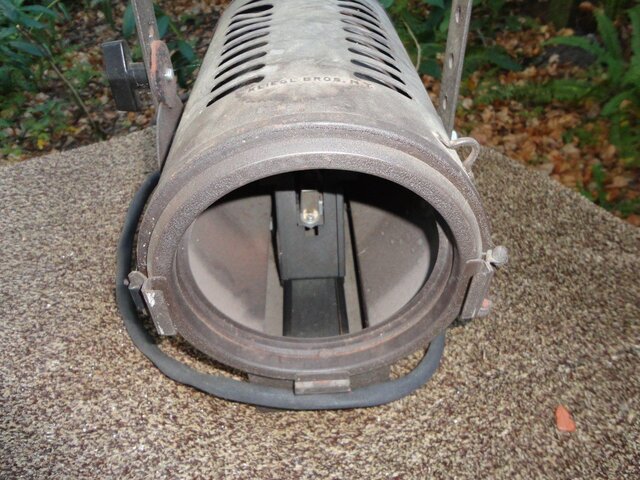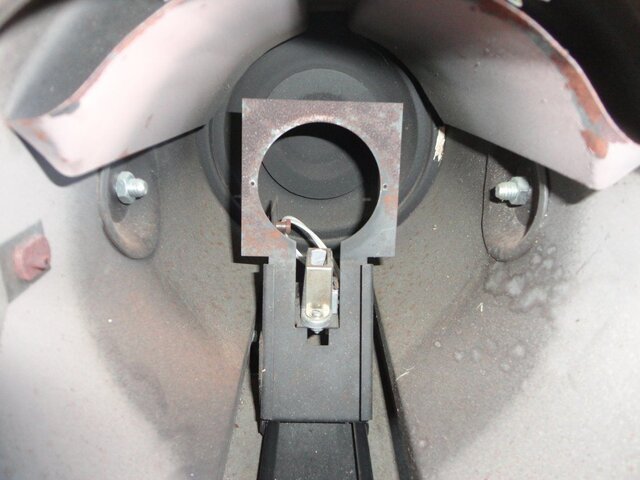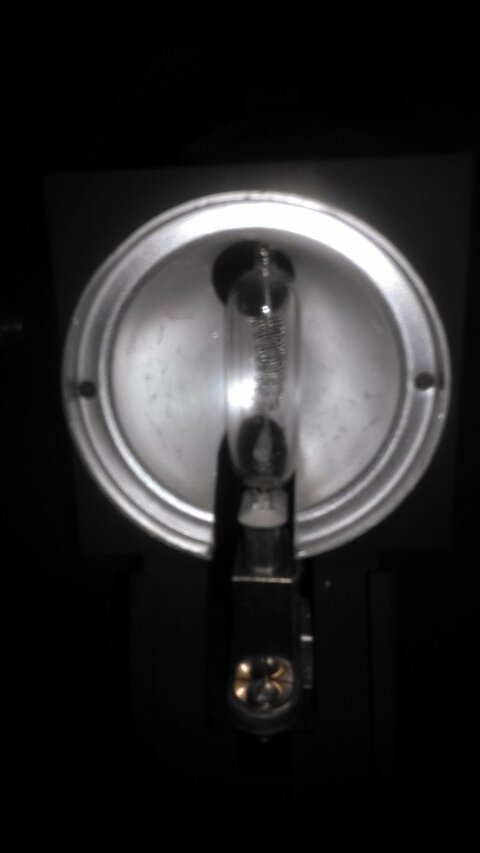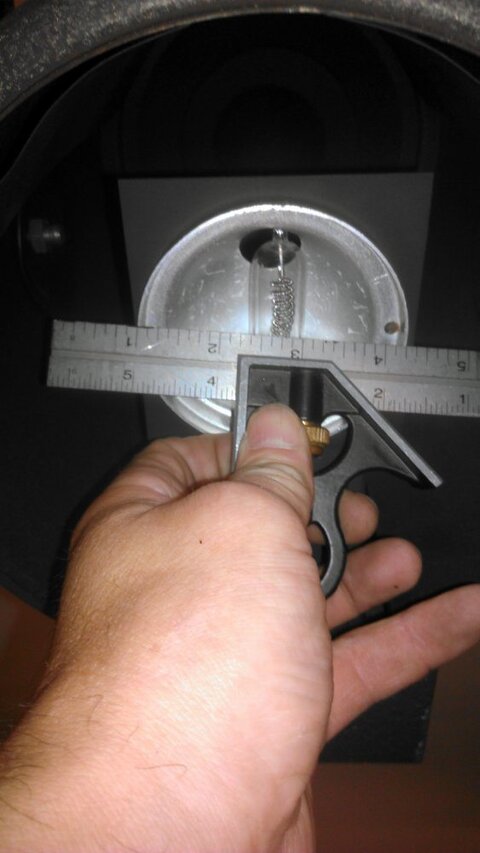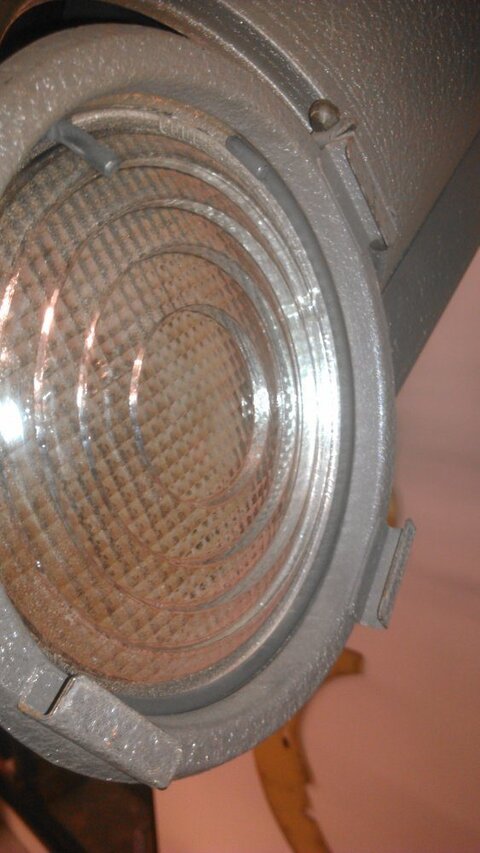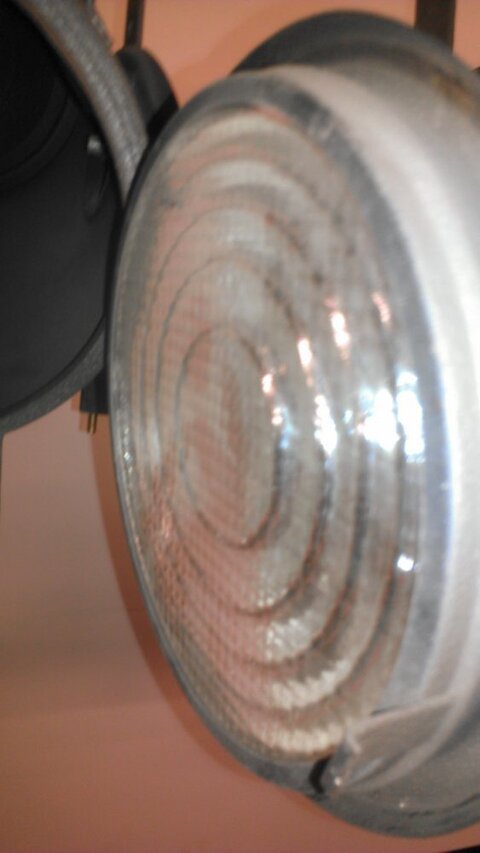Finally had time to pull out a ladder and look at the Kliegl #3606 on display for figuring out how I did the 6"
lens retrofit. Had I checked my inventory notes better, I will have noted that I also own one that’s complete, and that’s the one on display. The one I noted in retrofit was to another employee’s light and he took it home. The friend is on tour with no hope of providing photos or specifications on how I replaced his
lens with a 65Q
lens.
On the other
hand in seeing the light, I know what I will have done and how I would approach
lens and the
reflector issue also.
First, the lens... I would use a 6"
Altman Fresnel lens, especially if someone has extras for free. Otherwise suggested retail price is $35.00 new retail, and that with
reflector might be about the price of various internet used complete Fresnels that would need work, but less engineering work. Looked into other
Altman Fresnel lenses and either the 1KAL is smaller than 6" or another is 6.89" and too big.
Depending on how many lights you want to bring into service, I would have plasma or
laser cut some
donut rings for the front and rear of the
lens so as to bring the opening up to it’s proper size opening to support the now 6"
lens. This Kliegl
lens is 6.3/8" in dia. I measure about a 3/16" lip/flange on a 6"
Fresnel lens (Century) and about 5.3/4" actual opening at the door of the
Fresnel rear flange to support the
lens. So I would do an O.D. of 6.3/8" and I.D. of 5.11/16" given a thin
donut gauge of steel.
Sandwich the
lens between the
donut plates of like 20-22ga steel cut around 1/16" shorter in ID than that of the first step of the
lens. Note, dependant on the rear
lens retainer ID., it might not be necessary to cut a
donut for it. (Didn’t measure this dia. on the 3606, - but probably necessary the rear
donut also.)
If you don’t have that ability to have the donuts made, you can with some work make them by
hand - I did with a scribing dividers. Good
layout is needed, even better if printing a CADD drawing and sticking it to the metal with a photo fix or light adhesive to be sanded off later. Rough cut the
donut with fine tooth jigsaw, band saw or scroll saw, than a good like 80 grit of belt sander paper and a drum sander with equal sandpaper to refine down to 150 grit - and away you go. File and sand the hard edges once sized to the ID so as not to scratch the glass.
As a filler support and cushion to the
lens, I would add a 3/16" dia. or slightly larger up to 7/32" silicone O-ring or spline so as to center the
lens on the ring instead of the
donut.
Lens is supported by the O-Ring/Splining material in holding to center.
Donut rings just keep it from falling out of the
fixture. Might even add some spots of high temp. silicone adhesive to the assembly so as to hold it together during assembly or especially removal.
The steel
thickness of the
donut should be thin but as safe as possible in balance to support the
lens. You also want to take the factory paint off the original part of the rear
lens support of the door - every fraction of an inch will count in getting that
lens retaining ring to re-mount into its
groove. Mask and paint donuts and this door rear ring with high-temp
flat black spray paint for a less thick layer of paint covering the metal.
Given the
fixture has a
lens retaining ring as standard to most Fresnels - a little smaller than normal (like 1/8" dia.), but it’s still with the donuts going to possibly not seat into it’s
groove properly (especially with a 7/32" silicone O-Ring. I would add at least three sheet metal screws
thru the outer part of the
fixture lens housing door recess somewhere in front of the countersunk retaining ring so as to ensure this
lens could not pop out and also help seat it. Would take a little thought so as not to put the screw hole too close to the retaining ring in screw now added pressing too hard against the retention ring and possibly break the
lens, and also just close enough to tension and keep it in place.
On reflector... assuming nothing similar is sold, I would initially look to the
Altman 300L or 650L
reflector and retrofit to make this work unless a similar
reflector might work better in size. (TBA measuring both
reflector in size.) I measure the OD of the Kliegl 6606
reflector flange at 3.1/4" and actual
reflector inside the mounting flange at 2.3/4". (Didn’t measure depth.) An
Altman 100 "Inkie"would be too small and not near sufficient in heat
rating. Suggested retail price on the 300L
reflector is $25.00, for the 650L is $32.00.
Main problem is the lamp is seated inside the
reflector. It’s a little more
concave of a
Spherical reflector than a normal
Fresnel uses. Might be able to rear mount a 300L or 650L
reflector on the rear part of the
reflector mount without much loss of light. Given a less
concave reflector on the
Altman reflectors, more distance from the
filament if you mount the
reflector on the rear of it’s mount might work fine. Or you might need to add some standoffs to further distance the
reflector optically. Problem is if you add standoffs behind the mount, you will drastically reduce the beam spread of the
reflector. Removing the old
reflector mounting and creating a new more normal one if even the entire carriage assembly based off a 650L gapping would probably work better. Different lamp in seat height and
base type, but proximity of
filament center to the
reflector and axis of
reflector to
filament is a
base for design still.
Would otherwise be interesting to see if some Omni or Lowel DP’ reflectors might work as a concept.
Note the lamp countersunk into the
reflector kind of like on open faced studio lights such as these. I have not checked anything from Mole or Arri amongst other open faced
fixture brands at this
point, but similar in style of where the lamp is in relation to the
reflector. This even if a other than
spherical reflector in shape. Challenge is on such open faced studio
wash lights is, the lamp changes proximity to the
reflector instead of a fixed position to
reflector and changing proximity to
lens. And the
reflector shape is different and might not be as even a beam spread across the
lens even if optimized for the
lens given its proximity. Still would be curious to look at.
If I were going to do R&D into solving the
reflector problem, I might rent the four lights above to start research.
Reflector will be the biggest challenge if wanting to get these up and running. Search the theater hard for those reflectors... And also be suspect of the lamp sockets and wiring. If they also need replacement, this project would be over cost effective to do I think.
Photos didn't download. Will find time Tuesday to insert.



